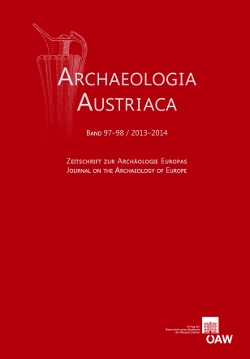|
 |
Artikel / Articles
Daria Ložnjak Dizdar, Mario Gavranović
Across the River. The cemetery in Dolina and New Aspects
of the Late Urnfield Culture in Croatian Posavina and
Northern Bosnia
Michael Brandl
Genesis, Provenance and Classification of Rocks within
the Chert Group in Central Europe
Katharina Rebay-Salisbury
Frauen in Österreichs Urgeschichtsforschung
Marc Händel
Al Hamriya – Dynamik einer Muschelhaufenlandschaft in
den Vereinigten Arabischen Emiraten
Beate Maria Pomberger, Jörg Helmut Mühlhans, Christoph Reuter
Forschungen zur Akustik der Prähistorie. Versuch einer
raum- und instrumentenakustischen Analyse
prähistorischer Bauten und Instrumente
Elisabetta Borgna
Ai limiti della periferia: Sulla funzione delle figurine
micenee nello scambio interregionale
Themen-Special
Die völkerwanderungszeitlichen Gräber aus
Gobelsburg, Niederösterreich
Herwig Friesinger, Marco Kultus
Völkerwanderungszeitliche Grabfunde aus Gobelsburg,
Niederösterreich
Friederike Novotny, Michaela Spannagl-Steiner, Maria
Teschler-Nicola
Anthropologische Analyse der menschlichen
Skelette aus Gobelsburg, Niederösterreich
Mathias Mehofer
Die Schmuckgegenstände und Trachtbestandteile aus den
völkerwanderungszeitlichen Gräbern von Gobelsburg,
Niederösterreich – Diskussion der analytischen
Ergebnisse
Christian Steinwender
REM-BSE Untersuchung an einem Cloison (FNr. 347) der
Ausgrabung Gobelsburg, Niederösterreich
Gabriela Ruß-Popa, Karina Grömer
Textil, Leder und andere organische Reste aus den
völkerwanderungszeitlichen Gräbern von
Gobelsburg, Niederösterreich
Angelika Rudelics, Karina Grömer
Katalog der Textilreste
Gabriela Ruß-Popa
Fundkatalog zu den völkerwanderungszeitlichen
Gräbern von Gobelsburg, Niederösterreich
Tafeln
Berichte
Violetta Reiter
Gräber der Frühbronzezeit aus Neumarkt an der Ybbs
− ein Überblick
Karl Großschmidt, Barbara Rendl
Das Gräberfeld von Neumarkt an der Ybbs. Pathologische
Fälle aus der Frühbronzezeit: Einäugig − Taub − Hinkend
– Metastasen
Reviews
Grzegorz Kiarszys
William S. Hanson, Ioana A. Oltean (Eds.),
Archaeology from Historical Aerial and
Satellite Archives (Springer:
New York, Heidelberg, Dordrecht, London, 2013)
|


